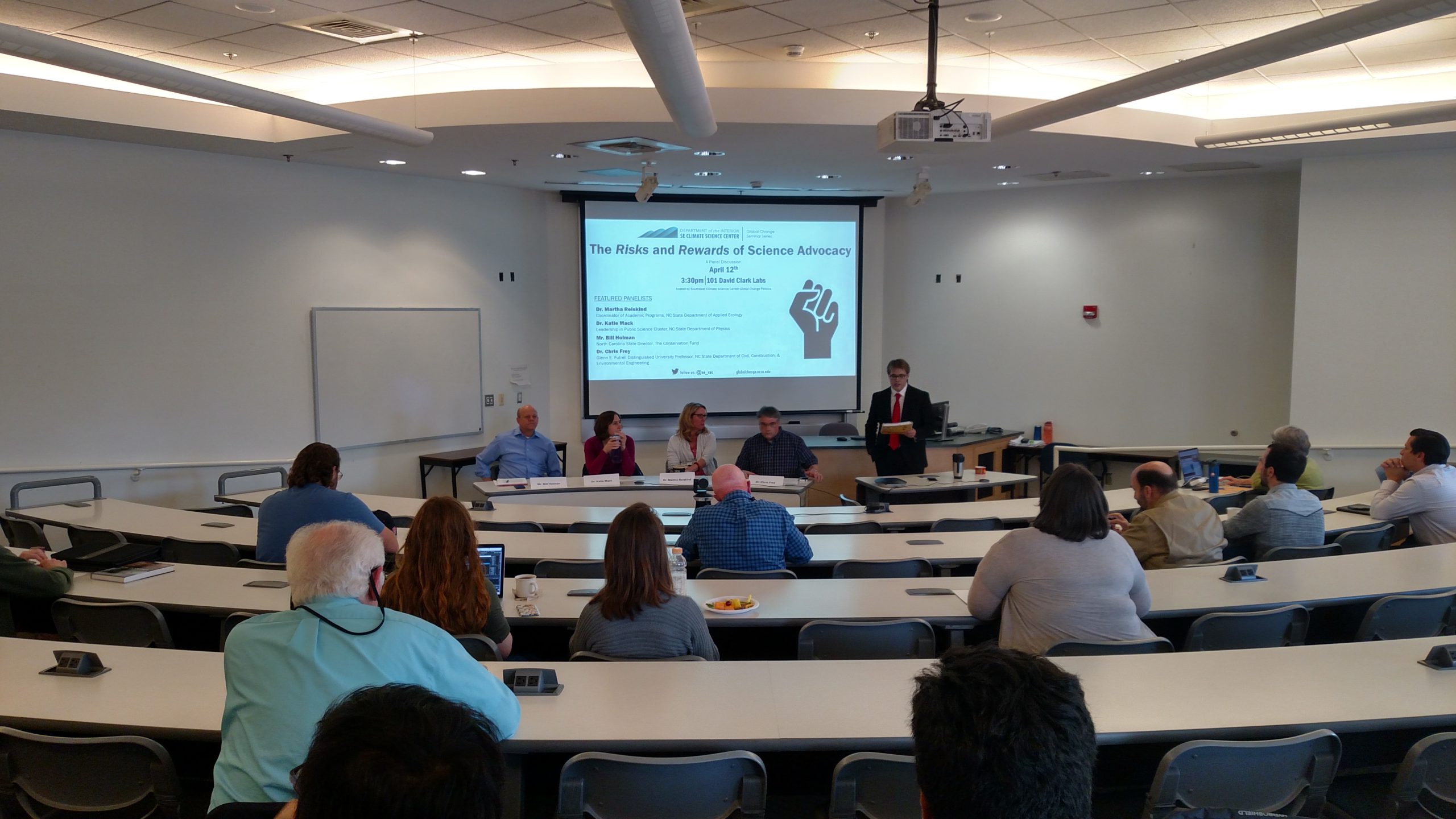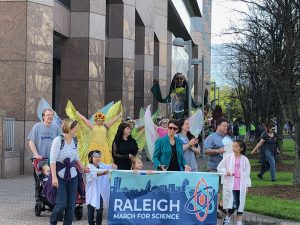Seminar Panel Discusses Science Advocacy


This post was written by Devon Gaydos, Spring 2018 Global Change Fellow.
April can be a time of introspection for researchers as events like Earth Day and the March for Science prompt us to consider the role our science plays in our communities and in our politics. With this in mind, the Southeast Climate Adaptation Science Center Global Change Fellows hosted their fourth and final Global Change Seminar of the semester titled “The Risks and Rewards of Science Advocacy” on April 12th. Fellow Mike Madden hosted a timely panel discussion about what it means to advocate for science in the public sphere. Panelists included Dr. Chris Frey from the Department of Civil, Construction and Environmental Engineering, Dr. Martha Reiskind from the Department of Applied Ecology, Dr. Katie Mack from the Department of Physics, and Mr. Bill Holman, the NC Director of the Conservation Fund.
Almost immediately the question was raised, “well, what do we mean by science advocacy?” From the diverse experiences of our panelists, it is clear that there are multiple flavors of advocacy stemming from different definitions of the problem. Each of these modes of engagement has unique risks and rewards.
Some have participated in what we think of as a more traditional activist role. Such is the case with Reiskind who spent much of her youth passionately fighting for habitat preservation on the frontlines of environmental movements. It was here that she encountered environmental lawyers who routinely rely on scientific information to fortify their legal battles. These experiences ultimately fueled her interest in pursuing a research career to “produce the best available science so that [she] can inform these litigious actions.” Like many other researchers, Reiskind has faced the challenge of how to balance the impartiality of science with her passionate personal beliefs. Through her work, she has learned to strike a compromise, stating “as I produce my own science, I do it without bias. But I advocate for that science and I advocate for the application and implications of that science.”
Another method is to work within the political realm to help craft policy based on sound scientific information. This has been Holman’s experience as an environmental lobbyist, environmental regulator, and North Carolina director of the Conservation Fund. As Holman put it, when crafting environmental policy “if you don’t have sound science, you don’t have a leg to stand on.” But translating scientific data into legal and political frameworks is not straightforward. Much of his work has revolved around compiling and reframing research in a way that decision makers, most of whom do not have a science background, can understand and act on. An additional challenge emerges when the scientific information is lacking. “You never have enough science. At some point you’ve got to make a decision. You use the best available science and make the best decision you can.”
Others choose to pursue something more akin to science advising than advocacy. Frey prefers to act as an honest broker, bringing the most up-to-date scientific findings to the table, but not advocating for policy initiatives on either side. By acting as a neutral science advisor, he maintains the credibility behind him and his science, giving him more access to the decision-making process. He also reminds us that science isn’t the only important factor in decision making. “As scientists, we have specialized expertise that could inform decisions. But as citizens, we’re no more special than anybody else. And we don’t get to decide whether society cares about climate change, but we can decide whether society knows about climate change.” While he feels that scientists do have an obligation to share this specialized knowledge and to “speak truth to power,” he reminds us that we are only one voice in this democracy and we cannot force our values on others. We can merely give them the best information with which to make decisions.

Along a similar vein, you can be an advocate by sharing science with the broader public. As Mack states, “I do think we have a big responsibility to make sure that the science we do is accessible to people.” Mack routinely shares the knowledge she’s accumulated as an astrophysicist through Twitter and by speaking at events such as the Raleigh March for Science. This communication is critical, not only to inform people, but to show people that scientists can be a variety of people. Science as a mode of thought is one of the best tools we have to understand the world around us. But science as an institution has not always lived up to the ideals of openness and inclusiveness, and we need to evaluate how the institution of science is interacting with the world. By putting ourselves in the public sphere, we can begin to break down stereotypes of scientists, and show others that they too can have a place in science.
While these modes of engagement have different outcomes and motivations, there is a common theme: communication is fundamental. Unfortunately, as Frey points out, “by and large, scientists are not great communicators.” This has helped fuel a lack of scientific literacy amongst the broader public. Although many people think that science is cool or important, people rarely understand the many different ways that it has impacted our daily lives. As Reiskind states “there’s a really important loss of the history of how science has gotten us to where we are.” In a similar theme, Frey comments “there’s all kinds of science success stories that I think people don’t know or appreciate. I personally think it would be helpful to share those stories.” By communicating the history of scientific advancements and how they’ve shaped the world today, we may be able to increase the public’s appreciation of science and clarify the need for science in public policy. Sharing success stories can also demonstrate how we may be able to pave a way towards a more sustainable and equitable future. As Holman states, “sometimes we forget we need to tell people we’ve solved these problems before, we can solve these too if we try.”
The question for scientists then becomes “which pathway makes the most sense for me?” As a young researcher, I have frequently wrestled with this question. Personally, I have found that it is impossible for me to be dispassionate about the pressing socio-environmental issues facing our society. As Reiskind put it, “People are denying scientific facts, or the scientific process even, and I think it is one of those times where it is important to be vocal about it and be passionate about it.” This passion fueled me to try out a new type of science advocacy this year by helping to organize the Raleigh March for Science. While the experience was overwhelmingly positive, I still have lingering questions about what impact it really had. We asked our panelists for their thoughts on the subject. Was it effective at changing public policy? Maybe not. But as Reiskind and Mack point out, there are wider-ranging benefits to getting scientists out of their silos and interacting with the public, especially with the youth. As Reiskind stated, “This march has really motivated young people to get impassioned,” which can have long-lasting influence.
In the end, each researcher needs to decide for themselves whether or not they want to engage in scientific advocacy and which methods best suit them and their work. But, I think everyone, not just scientists, can benefit from the wise advice from Holman: “Democracy depends on participation, but also good information… I encourage you to participate. Where you can shine the light, please shine it.”
- Categories:
